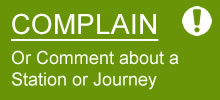SENRUG Chair Dennis Fancett travelled from Morpeth, Northumberland, to the North Face of the Eiger by train, and checked out how integrated transport Swiss style really does work.
Believe it or not, it’s possible to get all the way from Morpeth to Grindelwald, a small town in Switzerland, by train in a single day, thanks to East Coast’s new early morning departure from Morpeth at 6.35am, connecting with the Flying Scotsman service at Newcastle and delivering you to London at 9.40am. The connections are admittedly tight (you would need to negotiate the security checks at St Pancras before catching the 10.25am Eurostar), so we opted to go to London the previous evening using the new direct service from Morpeth at 7.53pm, and stay in a hotel. Our earlier departure from St Pancras at 8.02am the next morning delivered us safely to Grindlewald at 19.35pm, travelling via Paris, Lausanne, Bern and Interlaken Ost. We booked through Northumbria Travel in Bedlington, who were most helpful, and our Tour Operator Inghams thoughtfully included the Metro tickets for the transfer between Gare du Nord and Gare de Lyon in Paris. This gesture is far more valuable than the cost of the tickets, since Switzerland is a non-Euro zone country, and passengers only transiting through Paris are unlikely to have small change for the Metro tickets (although the ticket machines accept card payments). Astonishingly though, Inghams don’t tell you it is necessary to “compost” (date and time stamp) your European TGV tickets in the little yellow machine before getting on the train at Paris which is a serious omission.

In Switzerland itself, there are a variety of trains, mountain railways, cable cars, gondolas, busses and post busses but everything connects seamlessly and reliably. No problems with the wrong type of snow or leaves on the line here. The five minute connections at Bern and Interlaken Ost on our outward journey were achieved without difficulty, though I took the precaution of checking arrival and departure platforms for each train in advance with the Swiss rail website (www.rail.ch).

If travelling independently, you should book as far as your Swiss gateway city only (e.g. Lausanne or Basel) and then add internal Swiss transfer tickets as these tickets also give you half price travel within Switzerland for any other journey you make or pass you might buy. Remember to book UK tickets to and from “London CIV” or “London Eurostar”; this all-important designation entitles you to board the next train if a connection is missed under the European conditions of carriage.
We purchased a Jungfrau region public transport pass— expensive at £99 for 6 days (after the half-price discount - see https://www.jungfrau.ch/en-gb/jungfrau-travel-pass/) but well worth it, and slightly cheaper to buy in advance before leaving the UK. This gives free travel on all transport in the Jungfrau region except the final section of the mountain railway to Jungfraujoch itself, for which a supplement is payable. From Grindelwald, the mountain railway leaves every half hour, and climbs slowly up the north face of the Eiger.
Passengers from Grindelwald should note the train reverses direction at the next station (Grund) so sit facing the “wrong” way to start with for the best views for the main part of the journey. A change of trains is necessary at Kleine Scheidegg, from where a second line continues to Eigergletscher at which point it disappears into tunnels, first through the Eiger itself, then through the Monch, before emerging at Jungfraujoch station at 3,454 metres—just below the Jungfrau summit. There are two stations within the tunnels at which a five-minute stop allows passengers to alight and look out the windows carved into the rocks onto the exterior of the mountains, but no “way out” signs were visible. From these stations only an experienced mountaineer with all the equipment should venture outside.

At Jungfraujoch it is possible to leave the bewildering tunnel network and go on to the mountain itself. The views are impressive. We decided to venture across the glacier on a half mile walk through cleared snow to a mountain hut (actually a cafe and toilet stop). But be warned. The air is very thin and even just small steps take considerable energy, and we found ourselves short of breath at points, taking somewhat longer than the expected 45 minutes each way for the walk. And on no account leave the cleared path as all sorts of dangers lurk beneath the snow.
Public transport in Switzerland is so well integrated that it is not necessarily clear from the timetable whether a particular connection is by train, bus, cable car or some other mode of transport. It’s also noteworthy that the Swiss don’t seem to have any problem mixing passengers with light freight as most of the mountain railways have trucks on the back. Thus, pallets of bricks or cement or bulk foods are often forklifted on to the train out of sight of the passengers.
(Note: Train times, tour operator details, ticket and pass prices refer to a journey in 2011 and may no longer be current. Article originally appeared in and adapted from SENRUG Newsletter 17 Autumn 2011 - see https://www.senrug.co.uk/blog/wp-content/uploads/2019/01/1112Newsletter17.pdf).
Back to More...








